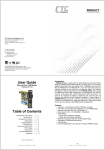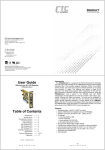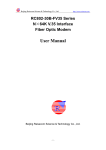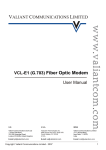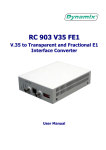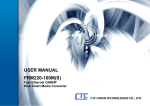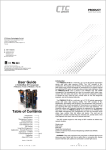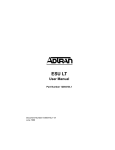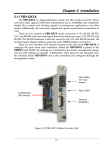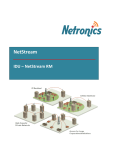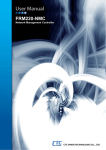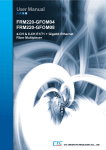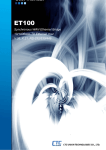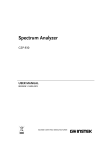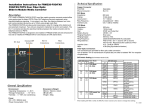Download FRM220-E1/T1 User Manual
Transcript
CTC Union Technologies Co.,Ltd. Far Eastern Vienna Technology Center (Neihu Technology Park) 8F, No. 60 Zhouzi St., Neihu, Taipei 114, Taiwan T +886-2-26591021 F +886-2-26590237 E [email protected] [email protected] [email protected] H www.ctcu.com 2009-2011 CTC Union Technologies Co., LTD. All trademarks are the property of their respective owners. Technical information in this document is subject to change without notice. User Guide G.703E1 and T1(DS1) over Fiber FRM220-E1/T1 (Fiber Optical Modem) Introduction The FRM220-E1/T1 family are stand-alone fiber media converters available in a number of different models that also act as cards for placement in the FRM220 Platform media converter chassis. The FRM220-E1/T1R is a fiber media transport for both G.703 E1 120 ohm and T1 100 ohm transmission with RJ45 connector. The FRM220-E1B model provides unbalanced E1 75 ohm coaxial connections. All media converters are available with either multi-model 2km or single-mode 15/30/50/80/120km optical transceivers and with connectors for SC, ST, FC. In single fiber WDM mode, the SC connector is also available in 20, 40, 60 and 80km. When the FRM220E1/T1 card is placed in the FRM220 rack with SNMP management, the card status, type, version, fiber link status, E1 or T1 link status and alarms can all be displayed. Configuration in also available to enable or disable the port, reset the port, do far end fault setting and initiate local or far end loopback tests. Features Table of Contents Introduction & Features Specifications Panel & Installation LED Indicators & E1 Pinout DIP Location, DIP 1 Setting DIP 2 Setting DIP 3 Setting Loop Back Tests Console Operation SFP Modules ------- 1 ------- 2-3 ------- 4 ------- 5 ------- 6 ------- 7 ------- 8 ------- 9 ------- 10-11 ------- 12-13 Interface connectors: RJ-48C for E1T1R, BNC x 2 for E1B Supports fiber connection to FRM220-DATA and FRM220-ET100 (E1 only) E1/T1, Line Code, Full or Fractional setting Frame setting, E1(CCS/CAS), T1(D4/ESF) CRC enable disable setting Idle code setting (0x7E or 0xFF) Auto laser shutdown setting Auto generation of blue (AIS) alarm enable disable setting AIS always generated in the event of fiber receive loss of signal Active timeslot number setting (E1 CCS 1-31, E1 CAS 1-30, T1 1-24 Base timeslot setting (E1 CCS 1-31, E1 CAS 1-15 and 17-31, T1 1-24) Loop Back (LLB,RLB,RRLB) set by DIPSW on front panel (when standalone) Timing source setting (Remote recovery, Internal oscillator, Local recovery E1/T1) Read DDOM of SFP (SFP model only) Version 1.1 November 2011 (update) -1w w w . C T C U . c o m w w w . C T C U . c o m Technical Specifications Optical Specifications Connector Type 1x9 Transceiver: ST,SC,FC or WDM (single fiber) SFP Transceiver: SFP or SFP WDM (single fiber) Optical mode Multi-mode or Single-mode Wave length 1310nm,1550nm,WDM Power Margin 11dB(2Km,M/M) ,12dB~ 35 dB(15 ~ 120Km,S/M) Data rate 36.864Mbps Line coding Scrambled NRZ Bit Error Rate Less than 10e-10 Test Loops -LLB (Local Loop Back) -RLB (Remote Loop Back) -RRLB (Far end remote loop back) E1 Specifications Ports Standards Framing Line Code Data Rate Min. Rx Level Line impedance 1 port ITU-T G.703,G.704,G.823 Unframed, PCM30(CAS) or PCM31(CCS) HDB3/AMI 2.048 Mbps -43dB 75 ohm for BNC type 120 ohm for RJ-48C type Pulse amplitude Nominal 2.37+/-10% for 75 ohms Nominal 3.0+/-10% for 120 ohms Zero amplitude +/-0.1V Connector E1/T1: RJ-45 E1: BNC x 2 Test Loops -LLB (Local Loop Back) -RLB (Remote Loop Back) -RRLB (Far end remote loop back) Bit Error Rate Less than 10e-10 T1 Specifications Ports Standards Framing Line Code Data Rate Min. Rx Level Line impedance Pulse amplitude Zero amplitude Connector Test Loops Bit Error Rate 1 port ITU-T G.703,G.704,G.824 Unframed, D4(SF) or ESF B8ZS/AMI 1.544 Mbps -36dB 100 ohm Nominal 3.0+/-20% +/-0.15V RJ-45 -LLB (Local Loop Back) -RLB (Remote Loop Back) -RRLB (Far end remote loop back) Less than 10e-10 Environment Operating Storage Humidity 0°C – 50°C 0°C – 70°C, 10 – 90%, (non-condensing) Power Adapter: Built-in AC Built-in DC Consumption 12V DC 1A 100~240 VAC 18~72VDC <4 watts Dimensions: (W x D x H) mm E1/T1-DC12 88 × 160 × 24 E1/T1-AC 135 × 201 × 35 E1/T1-DC48 135 × 201 × 35 E1/T1-AD 135 × 201 × 35 Weight FRM220-E1/T1 (card): 140g FRM220-E1/T1-DC12: 400g FRM220-E1/T1-DC48: 750g FRM220-E1/T1-AC: 750g FRM220-E1/T1-AD: 800g -2- -3- w w w . C T C U . c o m w w w . C T C U . c o m LED Indicators Panel Front Panel of FRM220-E1/T1 (RJ-45 and BNC models) TDM on Fiber LED PWR (Green) FX LINK (Green) E1T1 SIG TEST (Green) (Red) RD (Green) TD (Green) SYN (Green) AIS (Green) LED indicators E1/T1 on RJ45 FRM220-E1/T1 Loop back (manual) Installation Slide-in Card mounting of FRM220-E1/T1 This converter card can be placed in the CH01 with external AC adapter, CH01 w/built-in power, CH01M, CH-02M, CH02-NMC, CH08 or the full CH20 chassis. CH01 Chassis CH01M Chassis CH02M Chassis AC, DC, 2AC, 2DC, or AD State On Flash Off On Flash Off On Off On Off On Off Flash On Off Flash On Off On Off Status Power on During upgrade Power off or port disabled Fiber link Remote side sync loss Fiber no link E1/T1 Signal present Loss of Signal Loop Back Test active Normal operation Receive zero data Receive one data Data flow Transmit zero data Transmit one data Data flow E1/T1 Sync OK LOS or LOF Unit is transmitting AIS No local AIS alarm E1 Pin Assignment The RJ-45 connector follows USOC RJ48C wiring standard for a terminating unit. RJ48C utilizes pairs 1&2 and 4&5. In a terminating unit, pair 1&2 is receive signal while pair 4&5 is transmit signal. CH02-NMC Chassis AC, DC, 2AC, 2DC, or AD FRM220-CH20 Follow all ESD precautions when handling the card. Pin 1 – RxRing Pin 4 – TxRing Pin 2 - RxTip Pin 5 - TxTip -4- -5- w w w . C T C U . c o m w w w . C T C U . c o m DIP Switches On PCB DIP SW2 Rx Tx SW1 Tx Rx SW2 DIP SW1 1 SW3 SW STATE 1 OFF ON Function E1/T1 Setting E1 T1 2 OFF ON Line Code Setting HDB3(E1)/B8ZS(T1) AMI 3 OFF ON Full or Fraction Setting Full E1/T1 Fractional E1/T1 4 OFF ON Frame setting CCS(E1), D4(SF)(T1) CAS(E1), ESF(T1) 5 5 OFF ON CRC setting Disable Enable 6 6 OFF ON Auto transmitted AIS when received signal loss Disable Enable 2 3 4 7,8 7 OFF ON OFF ON 8 OFF OFF ON ON E1/T1 transmitted timing setting Recovery from remote side E1/T1 or DATA. Internal oscillator. Recovery from local E1/T1 receive. Reserved 1,2,3,4,5 SW STATE Function 1 OFF 2 OFF 3 OFF 4 OFF 5 OFF Fraction timeslot number Full E1/T1 1 timeslot ON OFF OFF OFF OFF OFF ON OFF OFF OFF 2 timeslot ON ON OFF OFF OFF 3 timeslot OFF OFF ON OFF OFF 4 timeslot ON OFF ON OFF OFF 5 timeslot OFF ON ON OFF OFF 6 timeslot ON ON ON OFF OFF 7 timeslot OFF OFF OFF ON OFF 8 timeslot ON OFF OFF ON OFF 9 timeslot OFF ON OFF ON OFF 10 timeslot ON ON OFF ON OFF 11 timeslot OFF OFF ON ON OFF 12 timeslot ON OFF ON ON OFF 13 timeslot OFF ON ON ON OFF 14 timeslot ON ON ON ON OFF 15 timeslot OFF OFF OFF OFF ON 16 timeslot 17 timeslot ON OFF OFF OFF ON OFF ON OFF OFF ON 18 timeslot ON ON OFF OFF ON 19 timeslot OFF OFF ON OFF ON 20 timeslot ON OFF ON OFF ON 21 timeslot OFF ON ON OFF ON 22 timeslot ON ON ON OFF ON 23 timeslot OFF OFF OFF ON ON 24 timeslot 25 timeslot (T1 does not use TS25~31) ON OFF OFF ON ON OFF ON OFF ON ON 26 timeslot ON ON OFF ON ON 27 timeslot OFF OFF ON ON ON 28 timeslot ON OFF ON ON ON 29 timeslot OFF ON ON ON ON 30 timeslot ON ON ON ON ON 31 timeslot 6 6 7 8 Auto laser shutdown setting OFF Disable ON Enable 7 OFF Unused timeslot idle code 0x7E ON 0xFF 8 Reserved -6- -7- w w w . C T C U . c o m w w w . C T C U . c o m DIP SW3 1,2,3,4,5 SW STATE Function 1 OFF 2 OFF 3 OFF 4 OFF 5 OFF First timeslot of contiguous TS setting Full E1/T1 Timeslot 1 ON OFF OFF OFF OFF OFF ON OFF OFF OFF Timeslot 2 ON ON OFF OFF OFF Timeslot 3 OFF OFF ON OFF OFF Timeslot 4 ON OFF ON OFF OFF Timeslot 5 OFF ON ON OFF OFF Timeslot 6 ON ON ON OFF OFF Timeslot 7 OFF OFF OFF ON OFF Timeslot 8 Timeslot 9 ON OFF OFF ON OFF OFF ON OFF ON OFF Timeslot 10 ON ON OFF ON OFF Timeslot 11 OFF OFF ON ON OFF Timeslot 12 ON OFF ON ON OFF Timeslot 13 OFF ON ON ON OFF Timeslot 14 ON ON ON ON OFF Timeslot 15 OFF OFF OFF OFF ON Timeslot 16 (except if E1 is CAS) ON OFF OFF OFF ON Timeslot 17 OFF ON OFF OFF ON Timeslot 18 ON ON OFF OFF ON Timeslot 19 OFF OFF ON OFF ON Timeslot 20 ON OFF ON OFF ON Timeslot 21 OFF ON ON OFF ON Timeslot 22 ON ON ON OFF ON Timeslot 23 OFF OFF OFF ON ON Timeslot 24 ON OFF OFF ON ON Timeslot 25 (T1 does not use TS25~31) OFF ON OFF ON ON Timeslot 26 ON ON OFF ON ON Timeslot 27 OFF OFF ON ON ON Timeslot 28 ON OFF ON ON ON Timeslot 29 OFF ON ON ON ON Timeslot 30 ON ON ON ON ON Timeslot 31 6, 7 6, 7 Reserved 8 8 OFF Loopback Group Fiber ON E1/T1 Panel Switch LB1 OFF LB2 OFF Loopback Group Loop Back DIsabled ON OFF Local Loop Back (LLB) OFF ON Remote Loop Back (RLB) ON ON Request Remote Loop Back (RRLB) Loop back Testing (LBT): This fiber modem incorporates loop back features which allow loop back testing to confirm that the fiber loop and interface transceivers are operating normally or not. Loop back is enabled by DIP switch or via NMC manager in FRM220 chassis E1/T1 Port Loop Back LLB Local Loop Back Local Side Remote Side Local Side Remote Side Local Side Remote Side Local Side Remote Side RLB Remote Loop Back RRLB Request Remote Loop Back Fiber Loop Back LLB Local Loop Back RLB Remote Loop Back RRLB Request Remote Loop Back -8- -9- w w w . C T C U . c o m w w w . C T C U . c o m Console Operation E1 Parameter settings FRM220-E1/T1 may be configured with a local serial console when the card is placed in either a CH01M or a CH02M chassis with serial console port connection. When console port is chosen for configuration, the DIP switch settings have no effect. Connect serial console using terminal emulation with settings: 38400, 8 bits, no parity, 1 stop, no low control (Press Enter key first to display menu) *************************************************** *** CTC UNION TECHNOLOGIES CO., LTD. *** *** FRM220 E1/T1 Ver:1.000-1.130-1.020 *** [Local] *************************************************** <1> :Port Active :[Enable] CH-01M FX Link :[Up] FX Signal :[Yes] FX FEF :[Off] RD State :[Flash] TD State :[Flash] Test State :[Normal] E1/T1 Signal:[Normal] Frame Sync:[Loss] Receive AIS:[No] Connector :[BNC] <2> :E1/T1 Parameter setting. <3> :Timing Source :[Recovery from remote side] <4> :Auto Laser Shutdown(ALS) :[Disable] <5> :Active Rate :[Full E1] <6> :Start Timeslot :[Full E1] <7> :Loop Back Setting :[Off] <8> :Port Reset. <9> :Set to Default. Small Form Pluggable(SFP):[Off] Digital Diagnostic(D/D):[Off] <N> <P> <Q> <S> E1/T1 Parameter Set Menu. <1> :E1/T1 Select :[E1] <2> :Line Code Setting :[HDB3(E1)/B8ZS(T1)] <3> :Full/Fractional :[Fractional] <4> :Framer Setting :[CCS(E1)/D4(T1)] <5> :CRC Setting :[Enable] <6> :Rx Loss Tx AIS :[Disable] <7> :Unused Timeslot Code :[0x7E] <ESC>: Go to previous menu. Please select an item. 1. E1/T1 Select: For converter with RJ-45, selects between E1 and T1 operation mode 2. Line code setting: For E1, selects between HDB3 and AMI; for T1, selects between B8ZS and AMI 3. Full/Fractional: Selects between unframed (2048K) or fractional (nx64) frame mode 4. Framer setting: When set for fractional operation, this selects the framer setting 5. CRC Setting: This enables or disables CRC4 for E1 or CRC6 for T1 6. RX Loss Tx AIS: Normal protocol requires AIS be transmitted in the event of receive signal loss. Enabling this provides this function. 7. Unused Timeslot code: The unused timeslots in fractional mode may stuff either 7E or FF value Active Rate :Go to the Remote Menu. :Password Setup. :Quit Terminal. :Save Setting Value. Description of Functions 1. Port Active: Use this to enable or disable this device 2. E1/T1 Parameter setting: Opens a sub-menu, explained on next page 3. Timing source: Selects between Internal oscillator, recover from E1/T1 or recover from remote (fiber) 4. Auto Laser Shutdown: Enable or disable the ALS safety function 5. Active Rate: sets the nx64 rate, shown on next page 6. Start timeslot: Sets the first timeslot of a contiguous group of nx64 timeslots 7. Loop Back Setting: Sets the fiber and E1/T1 loop back, shown on next page 8. Port Reset: Resets the CPLD chip and initializes the CPU 9. Set to default: Returns all settings to factory default D. Display SFP Information: Applicable only if converter has SFP module N. Go to remote card menu: Using EOC, enter the configuration screen for the remote card P. Password Setup: To protect against unauthorized access, a console password can be setup. Q. Quit Terminal: leaves the terminal menu S. Save Setting Value: Stores the parameter settings to the card IMPORTANT: Settings must be saved or they revert at next power on. Active Rates : <1>:64K <2>:128K <3>:192K <4>:256K <5>:320K <6>:384K <8>:512K <9>:576K <A>:640K <B>:704K <C>:768K <D>:832K <E>:896K <G>:1024K <H>:1088K <I>:1152K <J>:1216K <K>:1280K <L>:1344K <M>:1408K <O>:1536K <P>:1600K <Q>:1664K <R>:1728K <S>:1792K <T>:1856K <U>:1920K <W>:Full <ESC>: Go to previous menu. Please select an item. <7>:448K <F>:960K <N>:1472K <V>:1984K First Timeslot Start timeslot : <1>:TS1 <2>:TS2 <3>:TS3 <4>:TS4 <5>:TS5 <9>:TS9 <A>:TS10 <B>:TS11 <C>:TS12 <D>:TS13 <H>:TS17 <I>:TS18 <J>:TS19 <K>:TS20 <L>:TS21 <P>:TS25 <Q>:TS26 <R>:TS27 <S>:TS28 <T>:TS29 <ESC>: Go to previous menu. Please select an <6>:TS6 <E>:TS14 <M>:TS22 <U>:TS30 item. <7>:TS7 <F>:TS15 <N>:TS23 <V>:TS31 <8>:TS8 <G>:TS16 <O>:TS24 <W>:Full The active rate and first timeslot are used to select the contiguous range of timeslots to carry data/voice within the framed E1 or T1 transmission. - 10 - - 11 - w w w . C T C U . c o m w w w . C T C U . c o m Monitoring SFP models and SFP with DDOM *************************************************** *** CTC UNION TECHNOLOGIES CO., LTD. *** *** FRM220 CH01M E1/T1 Ver:1.000-1.130-1.020 *** [Local] *************************************************** Display SFP information. Vendor Name :[ FIBERXON INC. ] Vendor Part Number :[ FTM-3125C-L40 ] Fiber Type :[ Single ] Tx Wave Length :[ 1310nm ] Rx Wave Length :[ 1310nm ] Link Length :[ 40km ] Tx Power :[ +01dBm ] Rx Power :[ +02dBm ] Rx Sensitivity :[ +00dBm ] Temperature :[ +39C ] Installation of SFP Modules CTC Union supplied SFP modules are of the Bale Clasp type. The bale clasp SFP module has a bale clasp that secures the module into the SFP cage. Inserting a Bale Clasp SFP Module into a SFP cage Step 1 Close the bale clasp upward before inserting the SFP module. Step 2 Line up the SFP module with the port, and slide it into the cage. Removing a Bale Clasp SFP Module Step 1 Open the bale clasp on the SFP module. Press the clasp downward with your index finger. Step 2 Grasp the SFP module between your thumb and index finger and carefully remove it from the SFP cage. Identifying E1/T1 Card Version Upgrading FRM220-E1/T1 card may be firmware upgraded when it is placed in the FRM220 with NMC management card. The user may use a local console connection to the NMC, a remote Telnet (IP) connection, or a Web based (HTTP) connection with any available browser. The NMC communicates to all cards through a serial RS485 control bus. The upgrade code is transferred to the NMC by way of TFTP server. All of these mentioned upgrade methods are well documented in the FRM220-NMC Software Operation Manual. [Local] *************************************************** *** CTC UNION TECHNOLOGIES CO., LTD. *** *** FRM220 CH01M E1/T1 Ver:1.000-1.130-1.020 *** *************************************************** Each page viewed from the console menu has a ‘header’ that can identify the version of the E1/T1 card. There are three (3) fields shown. From left to right, these fields represent hardware, firmware and CPLD versions. In the above example, the card is About SFP Units The FRM220-E1/T1(S) accepts any SFP unit that complies with the MSA standard. Follow all ESD precautions when handling the card and SFP modules. Fiber optic components and cables are very sensitive to dirt, dust and mishandling, especially in high-speed networks. Dirty or mistreated fiber may cause errors and an unwanted degradation of signal quality. Remove the dust caps on SFP only when ready to plug in optical cables. Hardware Version: 1.000 Firmware Version: 1.130 CPLD Version: 1.020 When choosing SFP optical modules, the SFP must be able to support the required data rate. The optical data rate of this device is 36.864Mbps. Make sure the SFP modules chosen are suitable for the required data rate. - 12 - - 13 - w w w . C T C U . c o m w w w . C T C U . c o m









